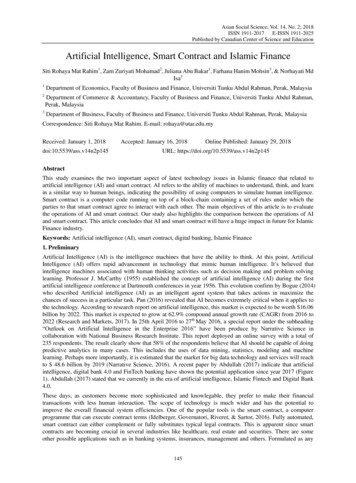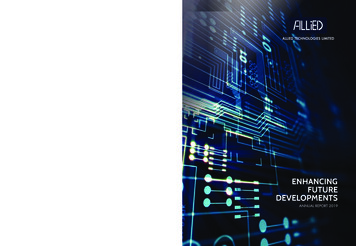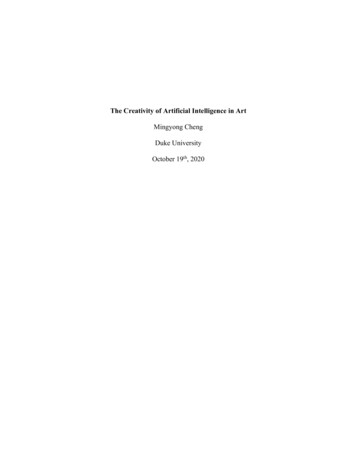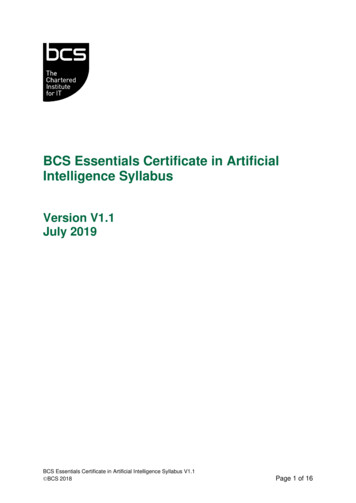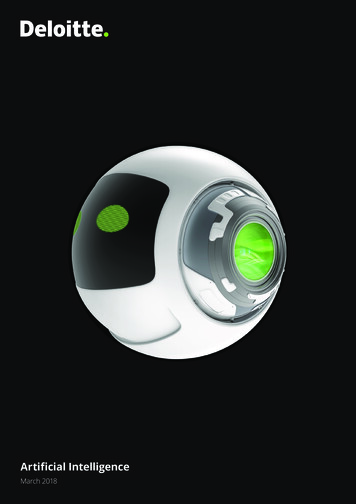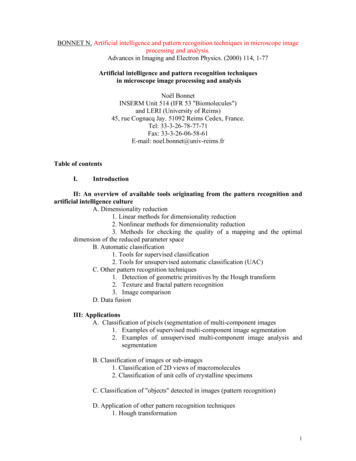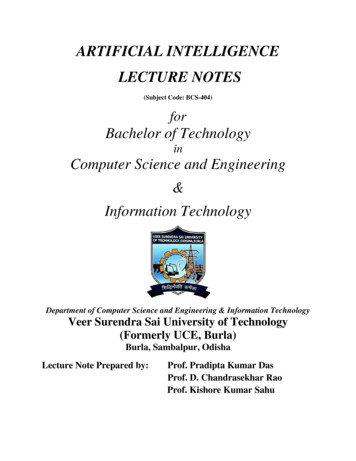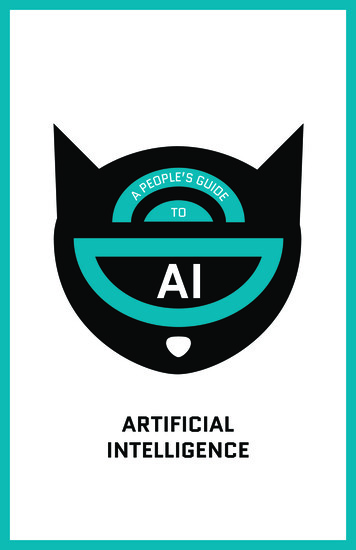
Transcription
ARTIFICIALINTELLIGENCE
TABLE OF CONTENTSA NOTE FROM THE AUTHORS3ABOUT THE AUTHORS6EVERYDAY AI7Glossary of TermsAI and the Quest to Compute the Human BrainAI in ActionUnderstanding AIEveryday AI ActivityALGORITHMSWhat is an Algorithm?Computer AlgorithmsEmbodying Social AlgorithmsMACHINE LEARNINGThe Difference Between AI and Machine LearningPattern Recognition and PredictionExamples of Machine Learning AlgorithmsDeep Learning: Computers That “Learn”Pattern Finder ActivityEQUITYAI in Social SpacesA Paradigm ShiftA Speculative Sci-Fi ActivityThe Agency We Have811162123293033364243454750535960687176WRITING Mimi Onuoha and Mother Cyborg (Diana Nucera)COPY EDITING Corin FaifeCONTENT SUPPORT Hannah DavisDESIGN AND ILLUSTRATION And Also TooPRINTING Whitlock (Michigan)SPECIAL THANKS Chancellar Williams, Eric Sears, Eyebeam, the participants of the2017 NetGain Retreat and 2018 Netgain Refiguring the Future eventTHIS BOOK WAS MADE POSSIBLE with support from the Open Society FoundationLICENSING/COPYRIGHT INFORMATION Creative Commons AttributionNonCommercial-ShareAlike 4.0 International LicensePRINT PUBLICATION DATE August 2018
A NOTE FROM THE AUTHORSArtificial Intelligence (AI) is changing our society.What do listening to music, taking a flight, and getting stopped bythe police all have in common? You might not realize it, but theseactions could all involve artificial intelligence (AI) at work.A PEOPLE’S GUIDE TO AIA NOTE FROMTHE AUTHORSFrom cars that drive themselves to computer programs that can talkwith humans, AI-based technologies are being deployed across allparts of society. This means that they’re used in everyday spaces (liketyping a text message) and in more serious situations (like decidingwho is more likely to commit crime).Because these technologies can process lots of information andmake complex tasks more efficient, AI presents huge opportunitiesfor societal change. But who gets to decide what that change lookslike and who it will affect? As we learn to deal with new technologies,we also have to learn how to deal with the challenges that surroundthem. AI, in particular, prompts two big questions for us as a publicto consider:3
What does fairness look like when computers shapedecision-making?Who is creating the future, and how can we ensure that thesecreators reflect diverse communities and complexsocial dynamics?A PEOPLE’S GUIDE TO AIThe consequences of AI affect everyone, but especially traditionallydisadvantaged communities like low-income groups and people ofcolor. The exact populations who are not widely included in currentconversations about the technology are the ones who face the greatest risk. What does a future of widespread AI mean for cities likeDetroit, Michigan, where 40% of the population is without Internet?What does it mean for undocumented people in rural and urbanareas who fear deportation? What does it mean for people working inindustries where AI has the potential to replace jobs?We may not be able to answer all these questions, but we can offera perspective on how to begin this conversation. We are inspired bythe legacy of popular education, which insists that in order for peopleto begin thinking critically, they must first have an understanding ofthe topic in relation to their own lives.With that in mind, this booklet aims to fill the gaps in informationabout AI by creating accessible materials that inform communitiesand allow them to identify what their ideal futures with AI can looklike. Although the contents of this booklet focus on demystifyingAI, we find it important to state that the benefits of any technologyshould be felt by all of us. Too often, the challenges presented bynew technology spell out yet another tale of racism, sexism, genderinequality, ableism, and lack of consent within digital culture.The path to a fair future starts with the humans behind the machines,not the machines themselves. Self-reflection and a radical transformation of our relationships to our environment and each other are atthe heart of combating structural inequality. But understanding whatit takes to create a fair and just society is the first step. In creatingthis booklet, we start from the belief that equity begins with education.This booklet can be used in a number of ways. Because each sectionbuilds off the last, it can be read sequentially, in the style of a4
traditional book. For those who wish to learn more about specifictopics, we recommend looking at the table of contents and choosingsections to read. For more hands-on learners, we have also includeda number of workbook activities that allow the material to be explored in a more active fashion.A NOTE FROM THE AUTHORSA PEOPLE’S GUIDE TO AIThe benefits ofany technologyshould be feltby all of us.We hope that this booklet inspires and informs those who aredeveloping emerging technologies to reflect on how these technologies can impact our societies. We also hope that this booklet inspires and informs black, brown, indigenous, and immigrantcommunities to reclaim technology as a tool of liberation.With love and solidarity,Mimi Onuoha and Mother Cyborg5
ABOUT THEAUTHORSMIMI ONUOHAA PEOPLE’S GUIDE TO AIis a Brooklyn-based artist, researcher, andtechnologist investigating the social implications of data collection. Her work uses text,code, performance, and objects to exploremissing data and the ways in which people areabstracted, represented, and classified.6MOTHER CYBORG(ALSO KNOWN AS DIANA NUCERA)is here to escort you into the future with love.In 2017 she released her debut album, PressureSystems, an opus to the power of self-transformation. She is an organizer and artist whosework focuses on developing popular educationmaterials that empower communities to usemedia and technology to investigate, illuminate, and develop visionary solutions to challenges. Her music and laser performance buildopportunities to connect stories, invigorate thesoul and elevate our collective consciousnessof technology.
CHAPTER 1EVERYDAYAI
CHAPTER 1: EVERYDAY AIGLOSSARY OFTERMSBecause this book contains terms that not everyone may befamiliar with, we’ve included a glossary below.1ALGORITHM A series of steps(or set of rules) for solving orperforming a task.ANDROID (In science fiction) Arobot with a human appearance.ARTIFICIAL Made or producedA PEOPLE’S GUIDE TO AIby human beings rather thanoccurring naturally, typically as acopy of something natural.ARTIFICIAL INTELLIGENCEThe theory and development ofcomputer systems able to perform tasks that normally requirehuman intelligence.AUTOMATION The technique,method, or system of controllinga process by reducing humanintervention to a minimum.COMPUTATION The use oroperation of a computer.CONSCIOUSNESS The fact ofawareness by the mind of itselfand the world.CYBORG A person whosephysical abilities are extendedbeyond normal human limitations by mechanical elementsbuilt into the body.DATA Individual facts, statistics,or items of information.DEVICE A thing made oradapted for a particular purpose,especially a piece of mechanicalor electronic equipment.DIVERSITY Diversity has cometo refer to the various backgrounds and races that comprise a community, nation orother grouping. In many casesthe term diversity does not justacknowledge the existence ofvariations in background, race,gender, religion, sexual orientation and so on, but impliesan appreciation of these differences. The structural racismperspective (see below) can bedistinguished from a diversityperspective in that structural1 The definitions were gathered from a series of sources including: The Aspen Institute, Wikipedia.com, & Webster’s Dictionary.8
PREDICTIVE POLICING TheINEQUITY Lack of fairnessrefers to what a society genuinely free from racism would looklike. In a racially equitable society, the distribution of society’sbenefits and burdens wouldnot be skewed by race; in otherwords, racial equity would be areality in which a person is nomore or less likely to experiencesociety’s benefits or burdensbecause of the color of their skin.(This is in contrast to the currentstate of affairs in which a personof color is more likely to live inpoverty, be imprisoned, drop outof high school, be unemployedand experience poor healthoutcomes like diabetes, heartdisease, depression and otherpotentially fatal diseases.) Racialequity demands that we pay attention not just to individual-level discrimination, but to overallsocial outcomes.INTELLIGENCE The ability toacquire and apply knowledgeand skills.MACHINE LEARNING Abranch of artificial intelligencein which a computer generatesrules and predictions based onraw data that has been fed into it.MARGINALIZEDCOMMUNITIES Social margin-alization is social disadvantageand relegation to the fringe ofsociety. Marginalized communities are those which are prevented from participating fully in theeconomic, social, and political lifeof the society in which they live.NATURE The phenomena of thephysical world collectively, including plants, animals, the landscape, and other features andproducts of the earth, as opposedto humans or human creations.RACIAL EQUITY Racial equityA PEOPLE’S GUIDE TO AIor justice.usage of mathematical, statistical and analytical techniquesin law enforcement to identifypotential criminal activity beforeit occurs.GLOSSARY OF TERMSanalysis takes account of thestriking disparities in wellbeingand opportunity that come withbeing a member of a particulargroup, and works to identifyways in which these disparitiescan be eliminated.ROBOT A machine capable ofcarrying out a complex series ofactions automatically, especiallyone programmable by a computer.NATURAL Existing in or causedby nature; not made or causedby humankind.9
CHAPTER 1: EVERYDAY AISENSORS A devicethat detects and responds tosome type of input from thephysical environment.SOCIAL DECISION-MAKINGThe act of making decisions thathave social consequences, orramifications that can be felt byindividual people.A PEOPLE’S GUIDE TO AISTRUCTURAL RACISM10A system in which publicpolicies, institutional practices,cultural representations, andother norms work in mutuallyreinforcing ways to perpetuateracial group inequity. Astructural analysis of racismidentifies dimensions of ourhistory and culture that haveallowed privileges associatedwith “whiteness” anddisadvantages associated with“color” to endure and adapt overtime. Structural racism is notsomething that a few people orinstitutions choose to practice.Instead it is a feature of thesocial, economic and politicalsystems in which we all exist.
When you hear the words “Artificial Intelligence”, what are thefirst four things that come to your mind?AI AND THE QUEST TO COMPUTE THE HUMAN BRAINA PEOPLE’S GUIDE TO AIAI ANDTHE QUEST TOCOMPUTE THEHUMAN BRAIN1.2.3.4.11
CHAPTER 1: EVERYDAY AIIt is through science fiction that many of us first learn how to thinkabout technology. Popular films and shows like Terminator, 2001: ASpace Odyssey, I Robot, Ex Machina, The Matrix, Westworld, and Hermay have shaped how you think about what a future with AI willlook like.Lots of popular narratives focus on machines that are conscious(meaning that they can think for themselves), and are working foror attacking their human creators. As a result, these stories push usaway from seeing where AI is being used now and from consideringthe potential of AI to unite us and help to solve large-scale problems.A PEOPLE’S GUIDE TO AIIn a sense, AI represents a quest to imitate the human brain. It’sabout making a machine brain that can mimic the kinds of tasks thatwe think are unique to humans. In other words, AI is about developing machines that can do what humans can. Considering how complicated the human brain is, it’s no wonder that we have only recentlybeen able to get machines to do this. After all, the human brain is socomplex that we as humans have not yet tapped into its full potential.What we do understand about the brain is that there are multiple intelligences within humans and that our social environment influences how these intelligences are regarded. If AI is about imitating human intelligence, which forms of intelligence are we actually trying tomimic? As you read the list below, think about what it would look liketo design a system with these attributes. What kind of informationwould be needed?Below is a list of multiple intelligences that are presentwithin humans:21. NATURALIST INTELLIGENCENaturalist intelligence designates the human ability to discriminateamong living things (plants, animals) as well as sensitivity to otherfeatures of the natural world (clouds, rock configurations). This abilitywas clearly of value in our evolutionary past as hunters, gatherers, andfarmers; it continues to be central in roles such as botanist or chef.2 These intelligences were discovered Howard Earl Gardner, an American developmental psychologist and the John H. and Elisabeth A. Hobbs Professor of Cognition and Education at theHarvard Graduate School of Education at Harvard University.12
Musical intelligence is the capacity to discern pitch, rhythm, timbre,and tone. This intelligence enables us to recognize, create, reproduce,and reflect on music, as demonstrated by composers, conductors,musicians, vocalist, and sensitive listeners.3. L OGICAL-MATHEMATICAL (AKA COMPUTATIONAL)INTELLIGENCELogical-mathematical intelligence is the ability to calculate, quantify,consider propositions and hypotheses, and carry out mathematicaloperations. It enables us to perceive relationships and connectionsand to use abstract, symbolic thought, sequential reasoning skills,and inductive or deductive thinking patterns.AI AND THE QUEST TO COMPUTE THE HUMAN BRAIN2. MUSICAL INTELLIGENCEExistential intelligence refers to the capacity to tackle deep questions about human existence, such as the meaning of life, why we die,and how our species arose.5. INTERPERSONAL INTELLIGENCEInterpersonal intelligence is the ability to understand and interacteffectively with others. It involves effective verbal and nonverbalcommunication, the ability to note distinctions among others, sensitivity to the moods and temperaments of others, and the ability toentertain multiple perspectives.A PEOPLE’S GUIDE TO AI4. EXISTENTIAL INTELLIGENCE6. BODILY-KINESTHETIC INTELLIGENCEBodily-kinesthetic intelligence is the capacity to manipulate objectsand use a variety of physical skills. This intelligence also involves asense of timing and the perfection of skills through mind-body union.13
CHAPTER 1: EVERYDAY AI7. LINGUISTIC INTELLIGENCELinguistic intelligence is the ability to think in words and to uselanguage to express and appreciate complex meanings. Linguisticintelligence allows us to understand the order and meaning of wordsand to apply meta-linguistic skills to reflect on our use of language.8. INTRAPERSONAL INTELLIGENCEIntrapersonal intelligence is the capacity to understand oneself andone’s thoughts and feelings, and to use such knowledge in planningand directioning one’s life. Intrapersonal intelligence involves notonly an appreciation of the self, but also of the human condition.9. SPATIAL INTELLIGENCEA PEOPLE’S GUIDE TO AISpatial intelligence is the ability to think in three dimensions. Corecapacities include mental imagery, spatial reasoning, image manipulation, graphic and artistic skills, and an active imagination.Which intelligences do you identify with the most?Which intelligence would you prioritize if you were in charge ofdeveloping an artificial intelligence system?14
What types ofintelligences arebeing prioritizedin the creationof AI?AI AND THE QUEST TO COMPUTE THE HUMAN BRAINWe know that AI involves developing computer systems that can dothings that humans are able to do. But to really understand AI, weneed to look at how it is already being used today.A PEOPLE’S GUIDE TO AIAI today is far from being conscious, but it is worth thinking aboutwhat types of intelligences are being prioritized in the creation of AI.After all, the intelligence we prioritize in our machines likely lines upwith the intelligence that we prioritize in our societies.15
CHAPTER 1: EVERYDAY AIA PEOPLE’S GUIDE TO AIAI IN ACTIONPointing to exactly what counts as AI and where itis being used is a surprisingly hard thing to do. Thisis because many examples of AI aren’t about thecreation of entirely new things. Instead, they areabout adding AI to existing things. Adding AI canspeed up a process, eliminate the need for humansto do something, or make a system more efficient.Take the example of self-driving cars. Maybe you’ve heard about companies like Waymo, Uber, and BMW that are all trying to build carsthat can drive themselves. This idea may sound crazy and futuristic,but when we break it down, we can see that it’s really just an extension of something that we have been doing for years: automating ourcars. When you automate something, you make it work with little tono human control. Over time, we’ve automated more and more partsof our cars. Older cars had manual transmission, or stick shift, where16
Self-driving cars push this idea to the extreme: why not just automate everything in a car? This used to seem impossible—we thoughtthat the process of driving a car was so complicated that only a human could do it. But AI is quickly changing things. Self-driving carscars have sensors that can take in information about exactly whatis around them, and AI is being used to sort through that information and determine how to react (for example, we want our cars torespond differently to a stop sign than to a yield sign).AI IN ACTIONthe human driver sets the gear the car is driving in. Today we haveautomatic transmission: you just put the car in one gear and go.We’ve provided more examples of ways in which AI shows up in yourlife. These show the many roles that AI plays—not in creating newobjects or applications, but in improving existing ones.VIRTUAL ASSISTANTSNowadays many companieshave created AI personal assistants that do some of thework that human assistants do.These AI assistants can take ontasks like scheduling meetings,figuring out how long it will takepeople to respond to emails, andfinding files in email inboxes.Chatbots are a common exampleof virtual assistants. If you’veever logged onto a website andhad a window pop up asking ifyou want to chat with a customeradvisor, keep in mind that youmight be interacting with an AIsystem! Already these assistantsare quite sophisticated, able tohandle all types of questions andrespond with accuracy. HANDWRITINGRECOGNITION or humans, recognizing handFwriting seems simple. But forcomputers, it’s way more challenging. A computer has to beable to make sense of all waysthat humans can write the samecharacter differently. However,handwriting recognition is oneexample of AI that has been integrated into our lives. When youdeposit checks from your mobilephone or into an ATM, AI is behind that ability for the machineto make sense of the lettersand numbers.A PEOPLE’S GUIDE TO AIRead the list and check the box next to the applications youhave experienced.17
CHAPTER 1: EVERYDAY AIA PEOPLE’S GUIDE TO AIFACIAL RECOGNITIONFacial recognition systems can identify people through digital images or video footage. Though the technology has existed for a longtime, in recent years it has improved dramatically . When you uploada photo to a social media site or save it to your phone and the systemcan successfully tell who is in the picture, AI is involved inthe process.Facial recognition is being applied in all sortsof different areas. On Facebook, it is usedto identify people in images so that it canbe easier for users to tag their friends inphotos. In China, some city governmentshave started using facial recognition toidentify jaywalkers from street cameras,with plans to issue fines automaticallyvia text message. At the beginning of2018, Amazon opened its first AmazonGo store in Seattle. Amazon Go storesdon’t have cashiers or check-out machines—instead, an AI system monitorsthe video feeds to identify who is choosing which items from the shelves.MACHINE TRANSLATIONMachine translation is language translation doneby a machine instead of a human. In the past, if youwere traveling to a part of the world where people spokea different language, you had to pull out a translation dictionary and hope for the best. Now you can take out your phone, openGoogle Translate, and be able to translate signs, menus, and phrases.Though the technology isn’t perfect, it’s thanks to advances in AIthat computers have become so much more effective at translatingbetween languages.18
Email spam filtering is an older example of AI. If you have an emailaddress and don’t find yourself constantly getting spam emails, thenyou have AI to thank! Rcognizing which emails are the ones you wantto receive and which are likely to be spam is a task that is only becoming easier because of AI techniques for classification.AI IN ACTIONSPAM FILTERING CONVERSATIONAL SYSTEMS RECOMMENDATIONENGINESThis is one form of AI that is all overthe web. Have you ever shopped onAmazon, decided to add something toyour cart, and then seen suggestions forthings other customers have bought afterbuying the same item? Or maybe you’ve watched avideo on YouTube and been given recommendations fora video to watch afterwards, or searched for images online andbeen shown other “visually similar” images. RecommendationEngines use AI to figure out which things are similar to otherthings, and then predict what you’ll like based on things thatyou’ve looked at or bought before.A PEOPLE’S GUIDE TO AIHave you ever asked Siri, Alexa, Cortana, or Google Home a question? Thesecomputer systems communicatewith people in ways that feel natural. They are powered by speechrecognition systems that use AI torecognize what you’re asking.19
CHAPTER 1: EVERYDAY AIDid any of these applications of AI surprise you?A PEOPLE’S GUIDE TO AIWhat are other places where you suspect AI is present?20
UNDERSTANDINGAIHopefully the examples in the previous sectionhave shown that AI isn’t just one thing. This isexactly why AI is so powerful: because it is a numberof different technologies that can be incorporatedinto almost any digital space to make things workmore efficiently.UNDERSTANDING AIA PEOPLE’S GUIDE TO AIOne way to thinkof AI is as saltrather than itsown food groupWith this in mind, one way to think of AI is as saltrather than its own food group. It’s less interestingto consider it on its own. But once you add salt toyour food it can transform the meal.21
CHAPTER 1: EVERYDAY AIOver the course of this booklet we’ll bring up more examples of AI inour everyday lives. But as it turns out, the definition of AI is a moving target. As we’ve already mentioned, AI is the development ofcomputer systems that can do tasks that normally would requirehuman intelligence.In 1950, computer scientist Alan Turing developed the Turing test todefine what it meant for a computer to be considered “intelligent”. Amachine passes the Turing test if a human interacting with it is unable to tell whether they are talking with a human or a machine.A PEOPLE’S GUIDE TO AIIn many ways, the forms of AI that we use today do pass this test. Infact, some of Google’s AI assistants try intentionally to sound likehumans, so that people won’t know they’re speaking to a computer.3AI has existed as a field of research since the early 1900s, and theideas that inform it—which we’ll talk about in later chapters andexplore in the workshops at the end of the book—go back centuries.But in recent times, the field has had a huge surge in popularity. It isonly in the last ten years that we have seen the availability of hugeamounts of information, computers that are powerful enough tomake sense of that information, and people who know how to writecode that can put both of those things together.These things have brought about the creation of a field calledmachine learning, which is responsible for some of the larger innovations in AI (like the software powering cars that can drive themselves). But to understand how machine learning works and why it'sso important, we have to take a step back, and learn about the rulesthat are at the heart of these systems.3 Some journalists and researchers have pointed out that machines trying to trick humans isnot ethical. ications22
EVERYDAY AI ACTIVITYAI is present in most of our everyday lives. Itdoesn’t look like the robots we see on TV—instead, it’s the name for a broad field with lotsof applications that can take many forms. Let’sexplore what AI in our everyday life looks like andidentify what the potential impact of it can be.Think about the devices and/or digital services you use daily.Write below a list of the top three that are present in your life.A PEOPLE’S GUIDE TO AIEVERYDAYAI ACTIVITY1.2.3.23
CHAPTER 1: EVERYDAY AIHave these things ever surprised you by guessing something aboutyou that you didn’t expect? Here are some examples:“One morning I noticed my phone created a heartfelt recap of theyear with my photos that made me tear up a little.”“One time I got an email and my email inbox suggested how Ishould reply to it.”A PEOPLE’S GUIDE TO AISee if you can recall a similar moment and write about it below.AI is very present in smartphones and Internet-based applicationswe use everyday. Sometimes, it might feel strange when you noticean application of AI—it might feel like someone is listening in on youand keeping track of your habits. Other times, you might think thatit’s useful, or helpful for something to know your patterns. Either way,being able to identify the many roles that AI can play can help youbegin to think about how it impacts your daily life.Take a moment to see if you can identify what function AI playsin the following list. If you get lost, go back to the examples ofAI In Action on page 17.24
AI FUNCTION(S)Email inboxEVERYDAY AI ACTIVITYDEVICE OR DIGITALSERVICE WITH AICheck depositingTexting and mobilekeyboardsGoogle (search function)A PEOPLE’S GUIDE TO AINetflixSocial media platforms(Instagram, Facebook,Twitter, etc)Automated message systemsNow that you have a better idea of what applications of AI in everyday life look like, let’s think about the impact that they have.25
CHAPTER 1: EVERYDAY AIWhat do we gain by having AI in our everyday lives?A PEOPLE’S GUIDE TO AIWhat do we lose by having AI in our daily lives?Sometimes, AI seems magical in how it can easily transform difficulttasks. But right now, AI is designed and implemented by large companies or governments. It is more like a bulldozer than a hammer.What we mean by this is that it’s a tool, but not a common one thateveryone can use, like a hammer. Like a bulldozer, it is somethingthat you need special training to work with and lots of money andresources to use on a meaningful level.But what if it were more widely available? What if there were tool kitsthat allowed you to access the materials needed to develop AI systems, just like there are tools that allow people to create websites?What would you build?Think about what you have learned so far about what AI is and howit shows up in our daily lives. Your task is to identify a problem thatyou see in your life, neighborhood, or community and design an AIsystem that could help address this problem.26
WHAT PROBLEMARE YOU TRYINGTO ADDRESS ?EVERYDAY AI ACTIVITYUse the prompts below to help design an AI system.WHAT ROLE WILLHUMANS HAVE INADDRESSINGTHIS ISSUE?WHAT DATA DO YOUNEED TO CREATE AN AITO HELP YOU ADDRESSYOUR ISSUE?A PEOPLE’S GUIDE TO AIHOW CAN AI HELPSOLVE THIS ISSUE?HOW WILL YOURESPONSIBLY GATHERTHIS DATA IN A WAYTHAT RESPECTSINDIVIDUALS’ PRIVACYAND CONSENT?27
CHAPTER 2: ALGORITHMSA PEOPLE’S GUIDE TO AI28Now that you have your AI systems framework, take a moment todraw your system. This can look like a flow chart, or be a drawing ofwhat you think the system will look like and where it will live. It’s upto you! Try to be creative.Use the box below to design your prototype system.
CHAPTER 2ALGORITHMS
CHAPTER 2: ALGORITHMSA PEOPLE’S GUIDE TO AIWHAT IS ANALGORITHM?We can’t talk about AI or machine learning withouttalking about algorithms.This is because algorithms are the basic buildingblocks of AI. In fact, algorithms are the buildingblocks of computer programs in general. But evenmore than that, they’re the building blocks of howmany of us live our lives.When you get ready in the morning, what do you do? Maybe you havea set routine: you might wake up, take a shower, brush your teeth,then eat breakfast. These are the steps you take so that you can beready for the day ahead of you.This is what an algorithm is: a series of steps that allow you toperform a particular task.In this case, the task is getting yourself ready for the day. But the taskan algorithm solves can be much simpler or much more complicated.30
A PEOPLE’S GUIDE TO AIEvery algorithm takes in defined inputs (the things being acted upon)and has the goal of producing defined outputs (the results you want).For example, maybe you have a set algorithm for making yourself asandwich for lunch. Your goal, or output, might be to make a sandwich that will fill you up. The inputs are all of the ingredients that willgo into the sandwich, and your algorithm is how you order and arrange these things so that you can get your desired result, or output,of a sandwich for lunch.WHAT IS AN ALGORITHM?As a result, most of us don’t even realize how much of our lives areorganized by algorithms.Cleaning your room could be another example of a personal algorithm. The goal, or output, is a clean room, and the input is yourroom as it currently is, containing the items in the room that you willmanipulate in some way. You might have a specific order for how youclean your room. Maybe you start by sweeping the floor, then youclean the wi
ARTIFICIAL Made or produced by human beings rather than occurring naturally, typically as a copy of something natural. ARTIFICIAL INTELLIGENCE The theory and development of computer systems able to per-form tasks that normally require human intelligence. AUTOMATION The technique, met
